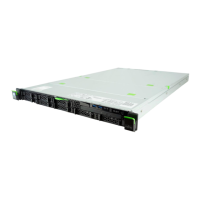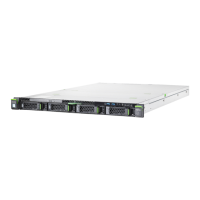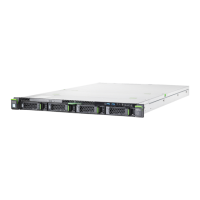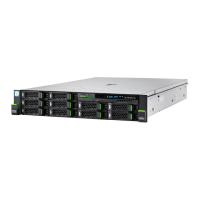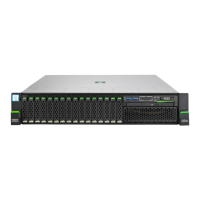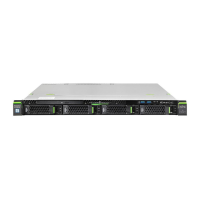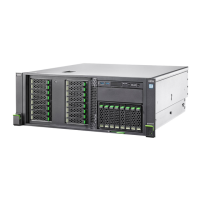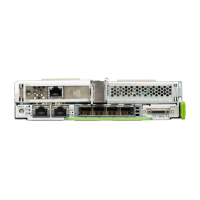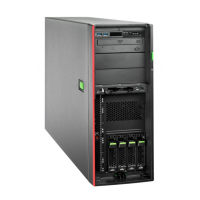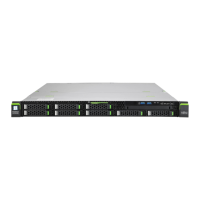
Do you have a question about the Fujitsu PRIMERGY RX2530 M4 and is the answer not in the manual?
| Form Factor | 2U Rack |
|---|---|
| Processor | Intel Xeon Scalable processors |
| Processor Sockets | 2 |
| Memory Type | DDR4 |
| Memory Slots | 24 |
| Maximum Memory | 3 TB |
| Management | iRMC S5 |
| Storage | SAS, SATA, NVMe |
| RAID Support | RAID 0, 1, 5, 6, 10, 50, 60 |
| Network Controller | Intel |
| Network | Ethernet |
| Power Supply | Redundant |
| Power Supply Options | 800W |
| Operating System Support | Windows Server, Linux |
Essential safety precautions and guidelines for using the server safely and correctly.
Information regarding potential radio interference from the device in domestic environments.
Clarifies the server's intended use and limitations for high-safety applications.
Recommendations for preventing issues caused by momentary power supply drops, like lightning.
Notes on export controls related to technology contained in Fujitsu documents.
States the server's compliance with harmonic current standards like JIS C 61000-3-2.
Specific information for Japan regarding SATA HDD usage and operation conditions.
Defines the manual's purpose and intended audience for server installation and operation.
Lists other manuals and resources for detailed information on the server and related software.
Explains symbols, formatting, and conventions used throughout the manual for clarity.
Details key features of the FUJITSU Server PRIMERGY RX2530 M4, including CPUs, storage, and management.
Outlines technical specifications such as system board, processor, memory, interfaces, and dimensions.
Provides critical safety guidelines for handling, installation, and operation to prevent injury and damage.
States compliance with European regulations and provides a link to the CE declaration.
Details compliance with FCC and Canadian standards for Class A digital devices and radio interference.
Covers environmentally friendly product design, energy saving, and packaging information.
Step-by-step guide on how to safely unpack the server and check its contents.
Instructions for securely mounting and dismounting the server within a rack system.
Explains how to connect external devices like keyboards, mice, monitors, and USB devices to the server.
Details the procedure for connecting the optional liquid cooling system to the server.
Guides on connecting the server's power supply units (AC/DC/HVDC) to the power source.
Provides essential precautions for safely connecting and disconnecting various cables to the server.
Describes the server's front and rear controls, buttons, and status indicators for operation monitoring.
Explains the function and location of the ID card containing system information for identification.
Covers the procedures for powering the server on, off, and related options like timer control.
Guides on configuring server hardware, including SATA and RAID controllers, and OS installation.
Provides instructions on how to safely clean the server and its peripherals.
Details how to use BIOS security features to protect system data from unauthorized access.
Offers solutions for issues where the server's power-on indicator does not light up.
Addresses problems related to the server unexpectedly shutting down due to detected errors.
Provides steps to resolve issues where the monitor connected to the server displays a blank screen.
Offers troubleshooting for monitor display issues like flickering stripes, often related to frequency settings.
Helps resolve problems with no screen output or unstable display due to incorrect resolution or frequency.
Guides on setting and maintaining the correct system date and time, and troubleshooting discrepancies.
Provides solutions for cases where the server fails to boot, particularly after installing new HDDs.
Explains common causes and solutions for drives being reported as "dead" during system startup.
Addresses issues where a newly added drive is reported as defective, often related to RAID configuration.
Directs users to documentation for understanding and resolving specific error messages displayed on the screen.
Offers solutions for when expansion cards or onboard devices are not detected by the system, usually driver related.
Explains temperature warning notifications and how to address potential overheating issues.
Provides troubleshooting steps for when the keyboard or mouse are unresponsive.
Offers solutions for optical drive issues, such as checking disk insertion, cleanliness, and condition.
